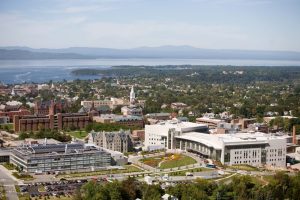Patient – Observer

Courtsey of UVM Medical Center Hospital
I’ve written much about the state of healthcare in the nation and here in Vermont.
As a former chair of then-Fletcher Allen Health Care some 20 years ago, a Vermont resident, and part of Vermont’s aging demographic, I want for us all to have the best possible care at a price the wide economic spectrum of Vermonters can afford, or ̶ as I believe is long overdue ̶ a government consensus that, in the richest country in the world, healthcare becomes a human right.
Today, we have a network of nonprofit hospitals in the state that vary widely in timely access and cost. Many needy Vermonters have despaired of getting the health services they need and simply age in place while others are resigned to long waits or even simply ‘do without.”
As a former hospital chair and retired businessman, I’m a person of “privilege.” I did not earn my retirement security “the old fashioned way,” by inheriting it, but instead earned it over the course of co-starting and running several businesses. I’m not in the one or two percent but I am in the 60th percentile for retirement income and so consider myself both lucky and privileged.
When I learned recently that I would need minor but invasive “transcatheter aortic valve replacement (TAVR)” heart surgery to live some more years, I was able to schedule it. The cost was largely paid by Medicare and I was able to meet the copay requirements, which were reasonable. My adult children, struggling to remember what the TAVR acronym stood for, simply said, “Dad’s having “trans-something surgery,” confusing many who know me.
Had I been among the 36% of Vermonters who are, by the Commonwealth Fund’s definition “underinsured,” I would have either had to forgo treatment, work out a “charity case” agreement with the hospital, or get treatment and declare medical bankruptcy. Vermont’s nonprofit hospitals are required to treat all who show up in need.
A distant family member, a healthcare professional who was treated recently at UVM Medical Center, had to negotiate a repayment agreement, as he was between insurance plans. He now pays $950 a month for his new policy alongside his monthly debt-reduction payment to the hospital or $22,000 a year.
I have another family member in New York whose health insurance costs $4000 a month to cover him, his wife, and child. $48,000 a year is 64% of the median household income of New Yorkers.
I could go on.
But I set out to write about how excellent the care I received at UVM Medical Center was.
I came in at 6:30 AM on a Friday and went home the following day at noon. The procedure, during which I was fully awake though given pain killers, lasted some 75 minutes. I spent four hours in recovery and then an overnight for observation.
During that time, the medical team that took care of me was humane, focused, and attentive. My doctor thoroughly explained the risks of the procedure, what could go wrong (but didn’t) and what my recovery would be like. He was precise and accurate on all counts. The lion’s share of my care was provided by attentive nurses, who not only focused on my physical care but on my mental comfort and sense of security.
I met and got to know some 15 LPNs, RNs, nursing assistants, and service staff. We had wonderful, unrushed conversations, both about my recovery and the current state of healthcare. I was surprised at the depth of concern many had about the failures of the healthcare system itself. Several had heard about and related personally to the term, “moral injury,” a situation in which the reasons that a person commits to being a healthcare provider (or educator) come into eventual conflict with the systemic practice of the institution they work for. Others spoke of “compassion fatigue.”
Many of the staff openly expressed their concern not for the quality of healthcare but for its exclusionary economics. Their perceptions were informed by their own experience with patients and reflected how much they had thought about the larger issues beyond their commitment to excellent patient care. I learned a great deal from these conversations which, sadly, confirmed some of my own fears, not about the quality of care at our hospitals but rather about economic and timely access to it.
In summary, my experience was extraordinary. It lifted my heart ̶ literally and spiritually ̶ to be among such committed professionals. I felt better within two days of my treatment and feel better every day. In the 1950s when I was a child, my recently diagnosed condition would have killed me within a few years. So much progress has been made in the intervening years.
Credit where credit is due. We have a cadre of professional and committed caregivers in Vermont in our various practices, clinics, and hospitals. Medicine, like life, is both science and art, and both are fallible. Our judgments must be relevant to reality. What we need at this point is an institutional and regulatory framework that makes our healthcare infrastructure available to all Vermonters by lowering (or largely eliminating) the appalling cost and the severe delays. Early diagnosis and treatment are the standard for quality healthcare.
Again, thank you to the team of committed medical professionals at UVM Medical Center who cared for me. I will always remember the quality of your care but will also persist in my ongoing efforts to ensure that the quality you provided me is available to all my family, friends, and neighbors.

